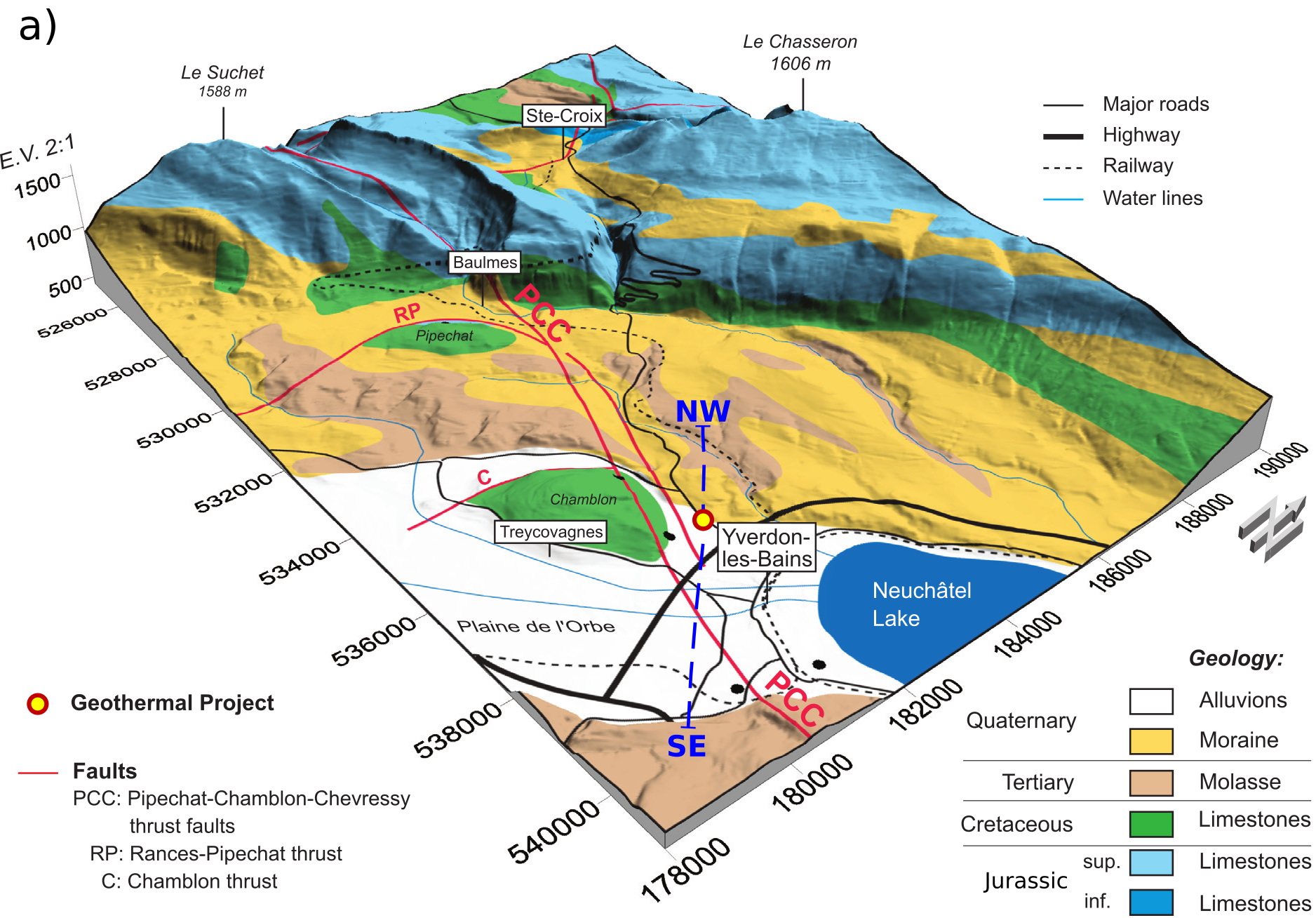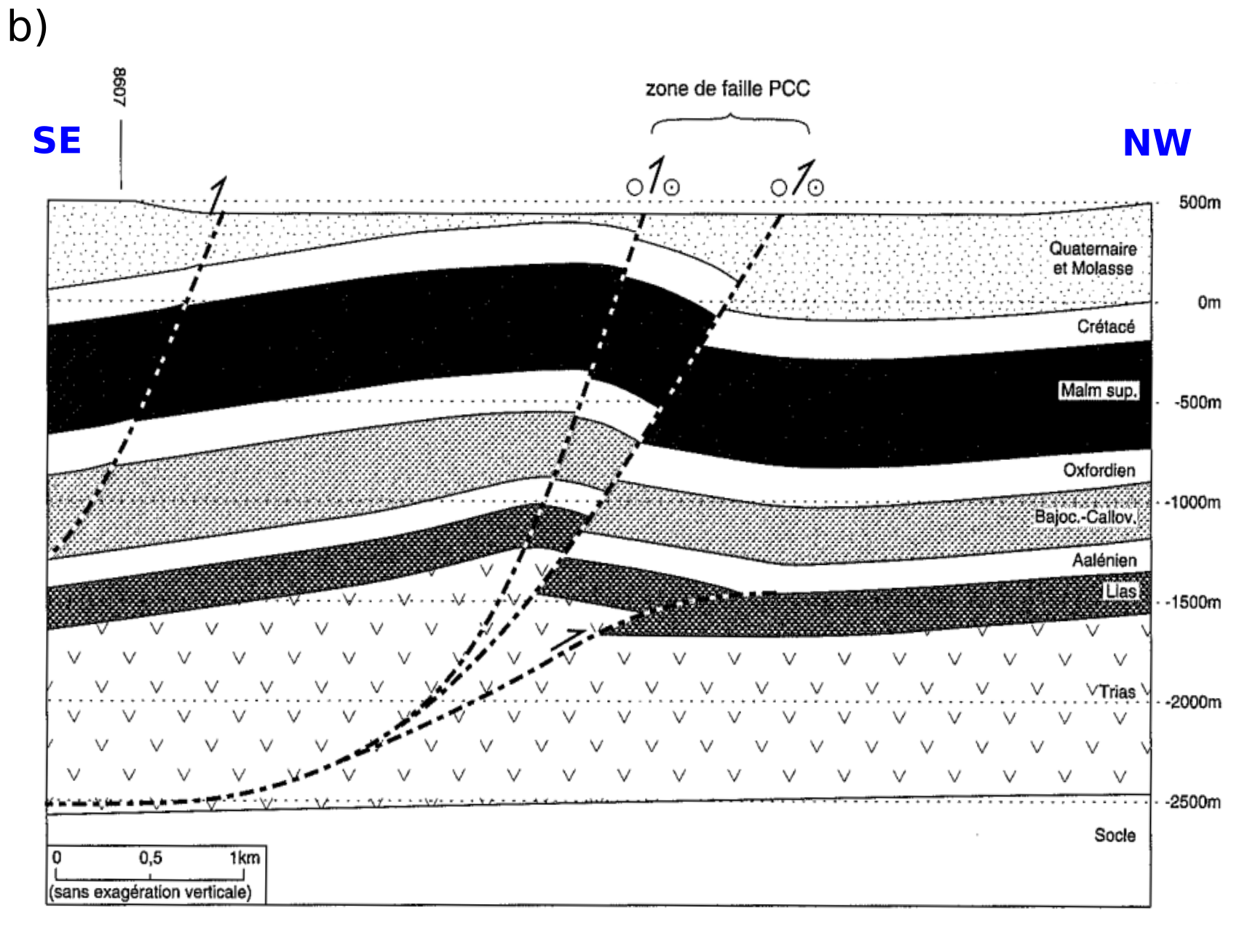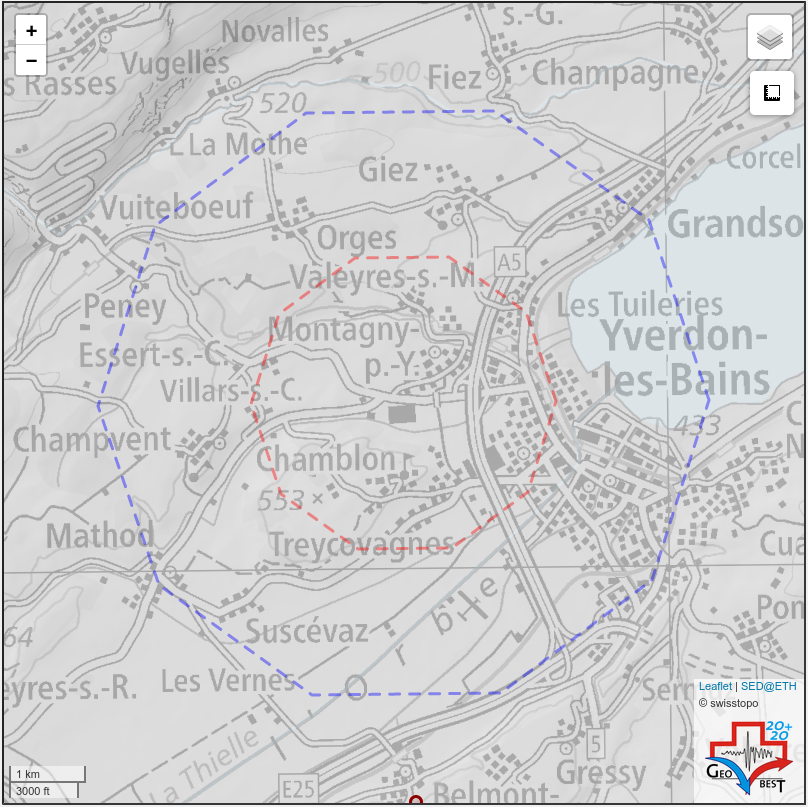Natural Local Seismicity
Yverdon-les-Bains is situated at the western tip of Lake Neuchatel in the southwestern part of the Molasse Basin and its transition to the Jura Mountains in the north (Fig. 1). The Jura Mountains are composed of limestone and marl rocks, which experienced passive transport and folding processes during the Alpine orogeny resulting in the typical fold-and-thrust structure of the Jura arc. This process also slightly deformed the Molasse Basin, a sedimentary foreland basin running sub-parallel to the Alpine front.
Two families of transpressive faults dominate the Yverdon-les-Bains area (Fig.1): 1) EW-oriented, right-lateral thrust faults, forming the 18 km-long Pipechat–Chamblon–Chevressy (PCC) fault zone; and 2) NS-oriented, left-lateral thrusts, like the western Chamblon (C) and Rances-Pipechat (RP) thrusts. The Pipechat and Chamblon mountains were lifted up along these complex thrust fault arrangements, exposing older carbonate rocks in the younger sedimentary rocks of the Molasse Basin [Jordi, 1993; Muralt et al.,1997; Pronk, 2009].
Fig. 1. a) Geological 3D-map of the Yverdon region (modified from Gainon, 2008).

Fig. 1. b) SE-NW cross section indicated in a) illustrating the lift-up of Mt. Chamblon along the transpressional PCC fault system (from Muralt et al., 1997).

For the pre-modern monitoring period, before 1975, the Earthquake Catalogue of Switzerland (ECOS, 2009) lists a total of 40 earthquakes in a distance range of 10 km of the Malménergie Naturelle project site. Eleven of these earthquakes had intensities of V (indicating slight damage) or larger. The strongest events reached magnitudes of 5.2Mw (1846, Mathod-Yverdon-les-Bains), 4.7Mw (1898, St. Croix-Yverdon) and 5.0Mw (1929, Bioley-Magnoux). Please note that the locations of these events were estimated from historical sources and not derived from instrumental seismic recordings. Therefore, their location uncertainties may reach several 10s of kilometers.
Between January 1975 (start of modern national seismic network) and December 2021, 22 earthquakes have been detected by the SED in the same region. Their magnitudes range from 0.9ML to 2.7ML, with eight earthquakes reaching magnitudes above 2.0ML. Vertically, the earthquakes are distributed over the entire earth’s crust. None of these earthquakes are located within a 2 km distance of the Malménergie Naturelle project site. The estimated completeness magnitude of the earthquake catalog for the modern monitoring period before installing the new network is 1.6ML in the area of interest, and smaller earthquakes may have been missed.
Fig 2. Alarming perimeter for the Malménergie Naturelle SA project.

References
Fäh, D., Giardini, D., Kästli, P., Deichmann, N., Gisler, M., Schwarz-Zanetti, G., Alvarez-Rubio, S., Sellami, S., Edwards, B., Allmann, B., Bethmann, F., Wössner, J., Gassner-Stamm, G., Fritsche, S., Eberhard, D., 2011. ECOS-09 Earthquake Catalogue of Switzerland Release 2011 Report and Database. Public catalogue, 17. 4. 2011. Swiss Seismological Service ETH Zurich, Report SED/RISK/R/001/20110417.
Gainon, F., 2008. Les isotopes radioactifs de la série de l’uranium-238 ( 222 Rn, 226 Ra, 234 U et 238 U) dans les eaux thermales de Suisse: Sites d’Yverdon-les-Bains, Moiry, Loèche-les-bains, Saxon, Val d’Illiez, Bad Ragaz, Delémont, Lavey-les-Bains, Brigerbad et Combioula. PhD Thesis, University of Neuchâtel, Neuchâtel.
Jordi, H.A. 1993. Tectonique du basin molassique et de son substratum jurassique-crétacé dans la region Orbe-Yverdon-Grandson. Bulletin de la Société vaudoise des Sciences Naturelles 82 (3): 279-299.
Muralt, R., Vuataz, F.D., Schonborn, G., Sommaruga, A. Jenny, J. 1997. Integration of hydrochemical, geological and geophysical methods for the exploration of a new thermal water resource. Case of Yverdon-les-Bains, foot of the Jura range. Eclogae Geologicae Helvetiae 90 (2): 179-197.
Pronk, M., 2009. Origin and Behaviour of Microorganisms and Particles in Selected Karst Aquifer Systems. PhD Thesis, University of Neuchâtel, Neuchâtel.